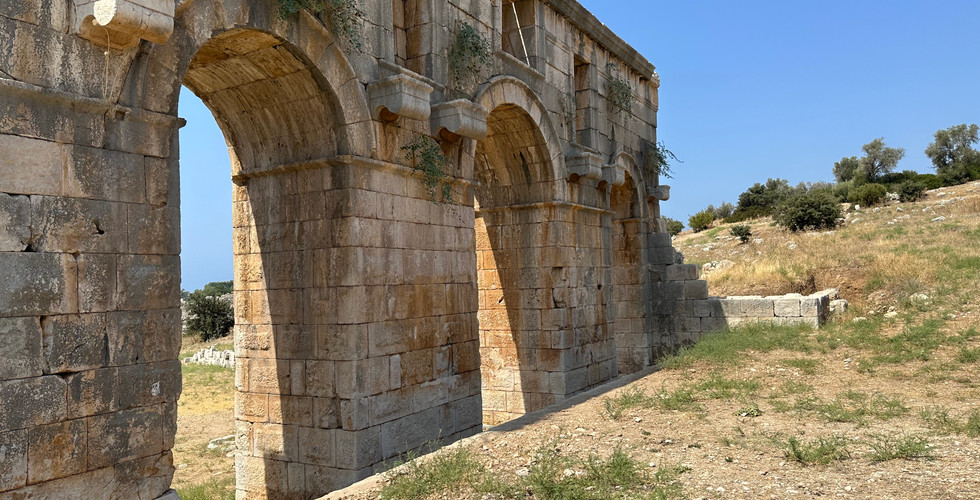Patara - A Large Ancient City with Tons of History
- Mika Vepsalainen
- Sep 23, 2023
- 4 min read
Join us for a visit to Patara, a village that has seen it all for thousands of years!

Join us for yet another visit to the fabulous ancient history. This time we shall visit Patara which is situated in the current city of Gelemiş of Antalya’s Kaş district. Due to its sheltered location, the original city was the primary port for Lycia, founded as early as in the 3rd millennium BC in the earliest Bronze Age.
As early as in 1200 BC, some Hittite texts mention Patara, referred to as Patar: “King Tudhaliya IV came to Patar with his army and made offerings.” The city was said to have been founded by Patarus, son of Apollo. It was known for the temple and oracle of Apollo, second only in importance to that of Delphi. Patara is also mentioned in the New Testament as the place where Paul of Tarsus and Luke changed ships.
The city was annexed to the Persian Empire ca. 540 BC and it became part of the First satrapa. The Athens took over in 468 BC until the Romans set Rhodes to govern the region for a short stint in 188 BC. Following a Lycian struggle for freedom the Roman Senate gave Lycia independence in 168 BC. The Romans reconquered Lycia In 43 AD and Patara became the capital of the Province of Lycia.
You can see these traces with your own eyes! There are 10th century ceramic fragments at the Tepecik Necropolis telling us that the region was inhabited from the Hittite Lukka to Homer's Lykia. Capital city of the Lycian League, Patara was one of the six cities in the Lycian League that had voting rights and today, the Council of the Lycian League is thought to be the world's first democratic council.
Through the wealth from the maritime commerce and oracle prophecy of the god Apollo, Patara became one of the wealthiest and largest cities in Lycia. However, the 542 AD plague pandemic caused massive loss of population, and the subsequent Arab raiding that occurred constantly in the 7th and 8th centuries AD, forced the inhabitants to recede to the mountains around Lycia. After 1176 AD, Lycia came under the Turk control. The latest known record from Patara dates from 1478 AD when Cem Sultan came to the city to conclude a treaty with the Rhodian.
Below, we list some of the tons of famous sights at Patara that you should definitely see.
The theatre on the wind-sheltered northern slope of Kursunlutepe, at the southern end of the city centre has an 80 m sitting circle for 6000 spectators.
The Harbour street runs north-south connecting the inner harbour agora, is the widest (12,60 m) and best preserved street in Lycia. Both sides of the street are lined with lonic order colonnades as wide as 6.00 m.
The lighthouse is located approximately 500 metres from the coast today. The inscription indicates that Emperor Nero ordered the lighthouse built “for the safety of the sailors” in 64/65 A.D.
The central bath is located to the east or the main street, northwest of the Nero/ Vespasian bath and southeast of the Corinth Temple. According to the traditional style, there are three sections aligned side by side in the east-west direction. The Seljuk bath next to the Frostylos temple was incorporated into the medieval fortification as the southeastern bastion. The third, the Harbour bath on the eastern edge of the ancient Patara Harbour has an underground heating system (hypocaust) and a sauna (laconicum). The Harbour Bath was first constructed in the 2nd century AD and remained functional till the 5th century AD after which it was used as workshop.
The Palm grove of Leto could have been the one that flourished in the rocky Delos although not all current archaeologists agree. In any case, the Apollo oracle centre at Patara was clearly equivalent to that of Delphi in Delos. The legendary early poet Olen was Lycian and he wrote hymns to Apollo at Delos while Vergillius uses the term "Lycian Apollo”!
The Octagonal fountain in the middle of the street was apparently built with the local limestone. The earthenware pipes stand still east of the structure, where they delivered water to the fountain. The water in the inner reservoir is canalized into the pool through fountains for public use.
The magnificent Triumphal Arch can be seen from the roadside, 2 km after Gelemiş village. The theatre on the slope of the hill was built during the reign of Emperor Antoninus Pius.
Patara's Lighthouse is believed to be the oldest lighthouse in the world and was built in 60 AD.
It is believed that Saint Nicholas - whose image then migrated into what we now see as Father Christmas - was born in Patara around 280 AD. During Nicholas’ lifetime, the harbour filled with silt and the city gradually lost importance. St. Nicholas actually lived most of his life in Myra (Demre) nearby.
There is a very nice small museum shop where you can find real size replicas of Patara statues and much more. There is also a small café at the shop serving cold and hot drinks. The loos are clean and accessible.
There is a free parking area at the museum entry and the agora and its surroundings are accessible to see but there are no proper paths any more when you move further to the Leto or the Corinthian temple. The excavations and scientific analysis are still underway and hopefully one day we can see whole of Patara as it was originally!
After the trip you might wish to check the 18 km long Patara beach which is probably the longest in the world. The dunes in the middle are fantastic. On a clear day, you can even see Rhodes Island from there.
Patara Ancient City
Kalkan, 07960 Kaş/Antalya, Türkiye
https://turkishmuseums.com/museum/detail/1968-antalya-patara/1968/4


























Comments